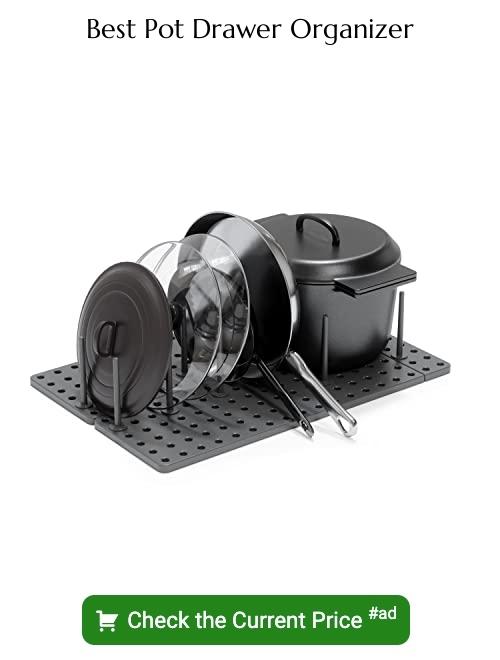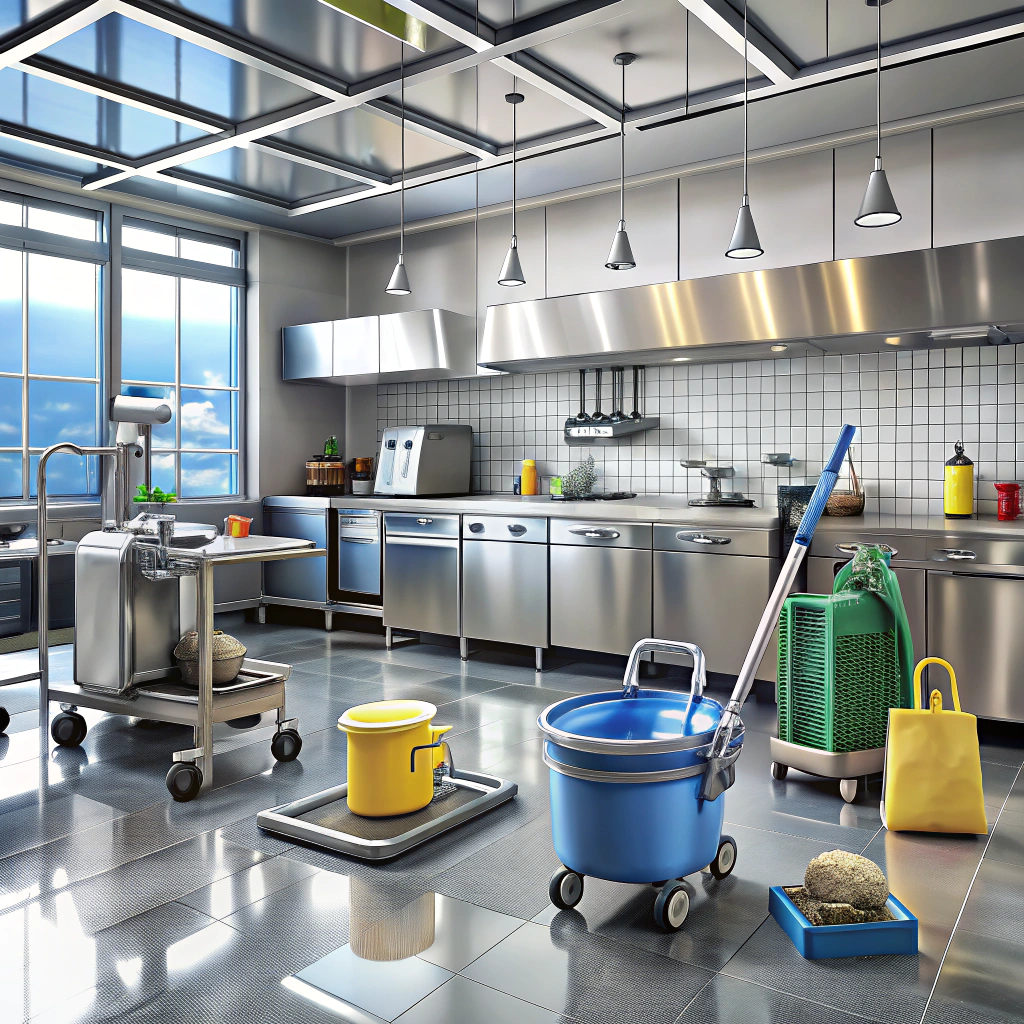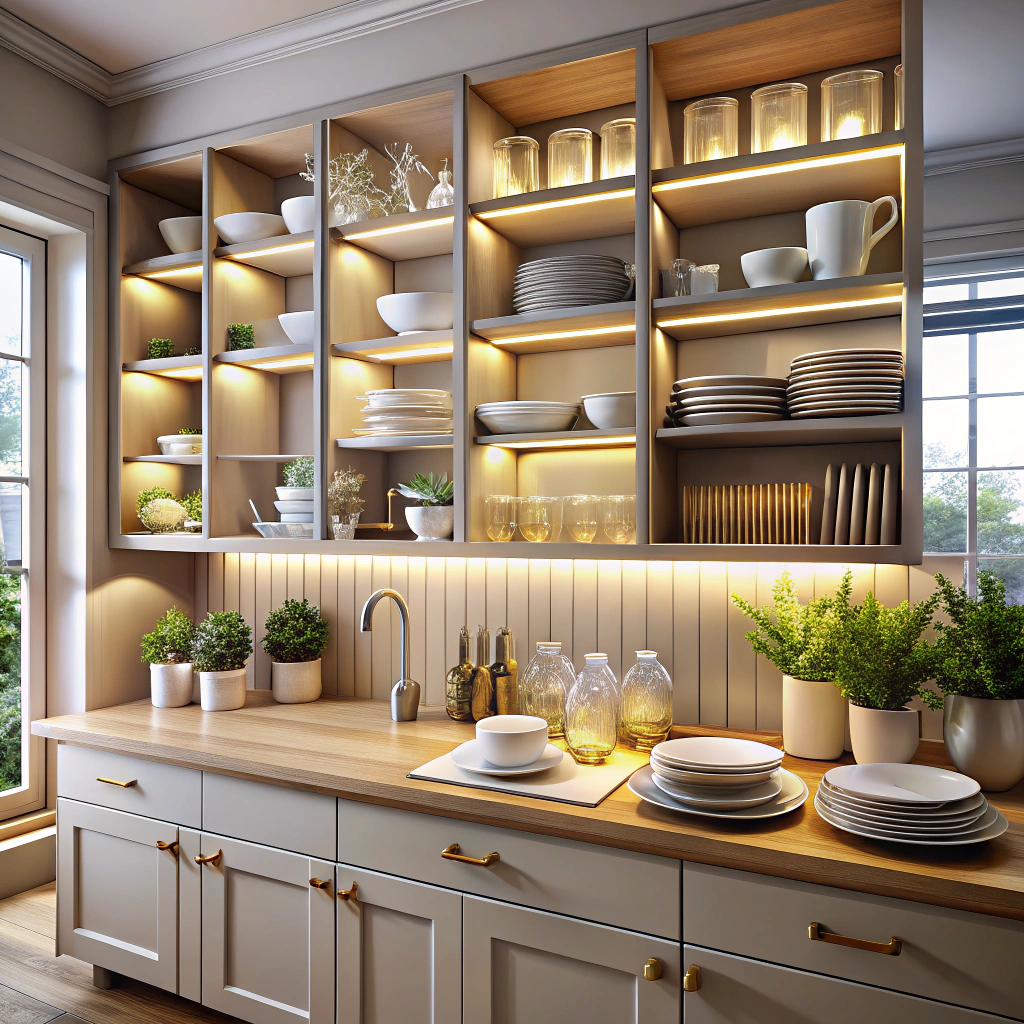Last updated on
You’ll want to keep reading because this article will unravel unique pot drawer cabinet ideas that revolutionize kitchen storage and tidy spaces.
These are my unique design concepts made using design tools. I hope you find them inspiring!
Dive into the flourishing world of pot drawer cabinet ideas! While the internet has a dizzying array of suggestions, we’ll go beyond conventional designs, exploring innovative new angles as we aim to outshine them with fresh and unique arrangements.
What’s more, we’ll wrap up with resources to some of the best known ideas out there. So, strap in for an enthusiastic journey through a thoughtfully curated list designed to inspire and reinvent your kitchen storage.
What's Inside
Make Use of Vertical Cabinet Dividers
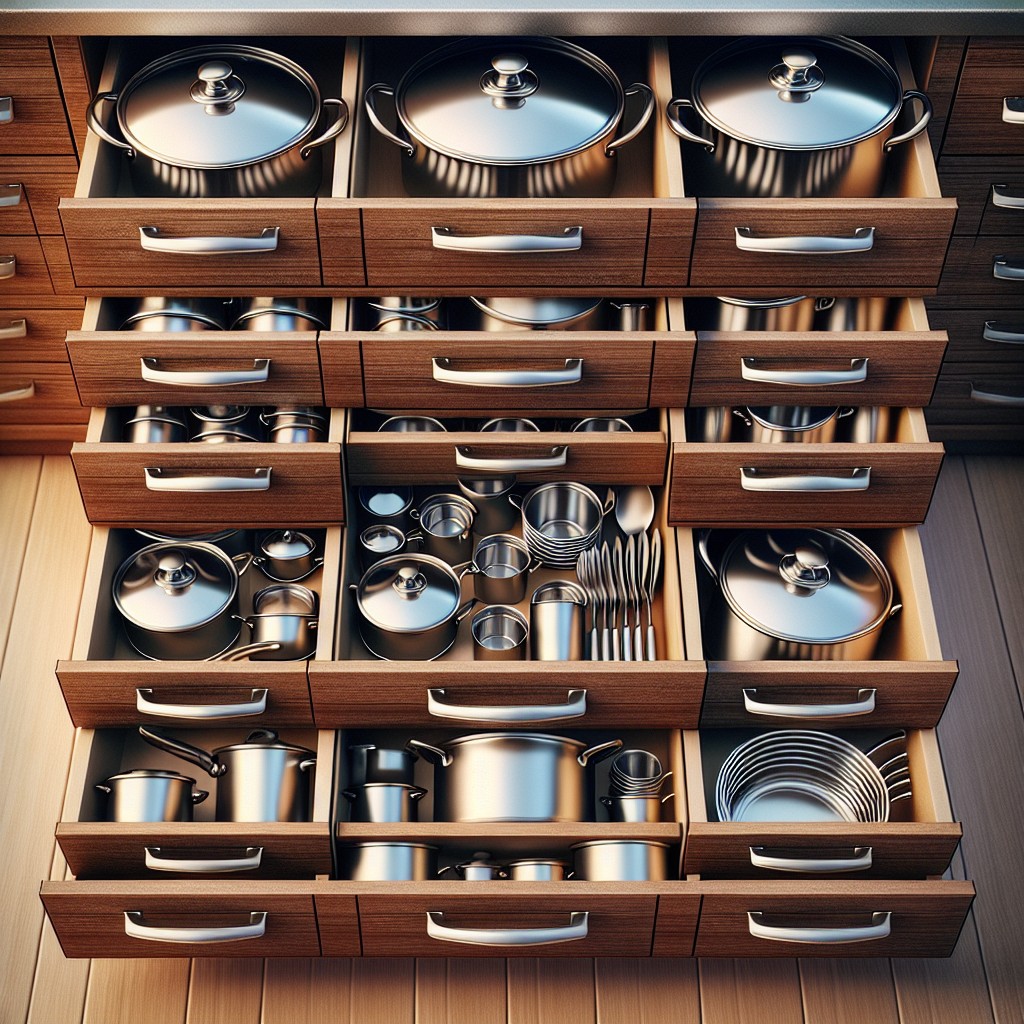
Vertical dividers work wonders in organizing your cookware. They create mini compartments within cabinets that can hold your pots upright, making retrieval easy. Dividers can be custom made to match your kitchen design or you can use tension rods for a quick conversion.
Besides pots, these dividers do a perfect job of neatly storing cutting boards, cookie sheets or serving trays. A fantastic upside to this arrangement is the effective protection it offers your cookware from scratches, as pots are not stacked on top of each other.
Easy to install, practical, and space-saving, vertical cabinet dividers are the secret weapons of tidy kitchens! Make sure to measure your cabinet properly before purchasing or creating dividers to ensure a snag free fit.
Cabinet Drawers With Adjustable Dividers
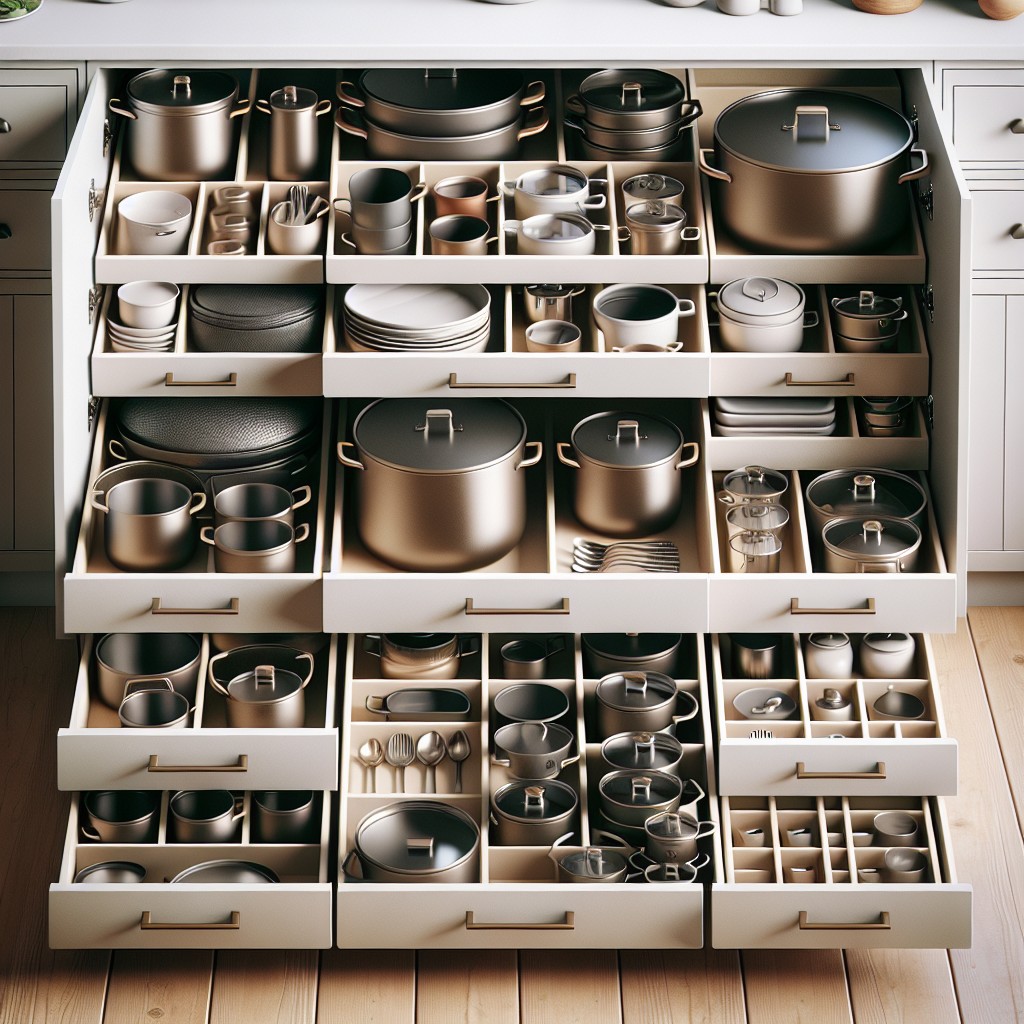
Adjustable dividers transform ordinary cabinet drawers into highly organized spaces for pots and pans. Here’s how you can incorporate them in your kitchen:
1. Flexibility: Configure the dividers to accommodate pots of various sizes, making custom-sized compartments.
2. Optimization: Use the full potential of deep drawers by lining them vertically with dividers. Store your pots upright and access them conveniently.
3. Multi-purpose: Not only are they apt for storing pots, but also ideal for nesting pans, lids, and other cookware.
4. DIY: Making your adjustable dividers can be a fulfilling project. All you need is some wood, a saw, and your creativity.
5. Sequence: You can arrange cookware based on frequency of usage. Keep daily-use pots towards the front and less frequently used ones at the back.
Implementing this solution paves the way for a more efficient and clutter-free kitchen.
Under-the-sink Storage for Pots and Pans
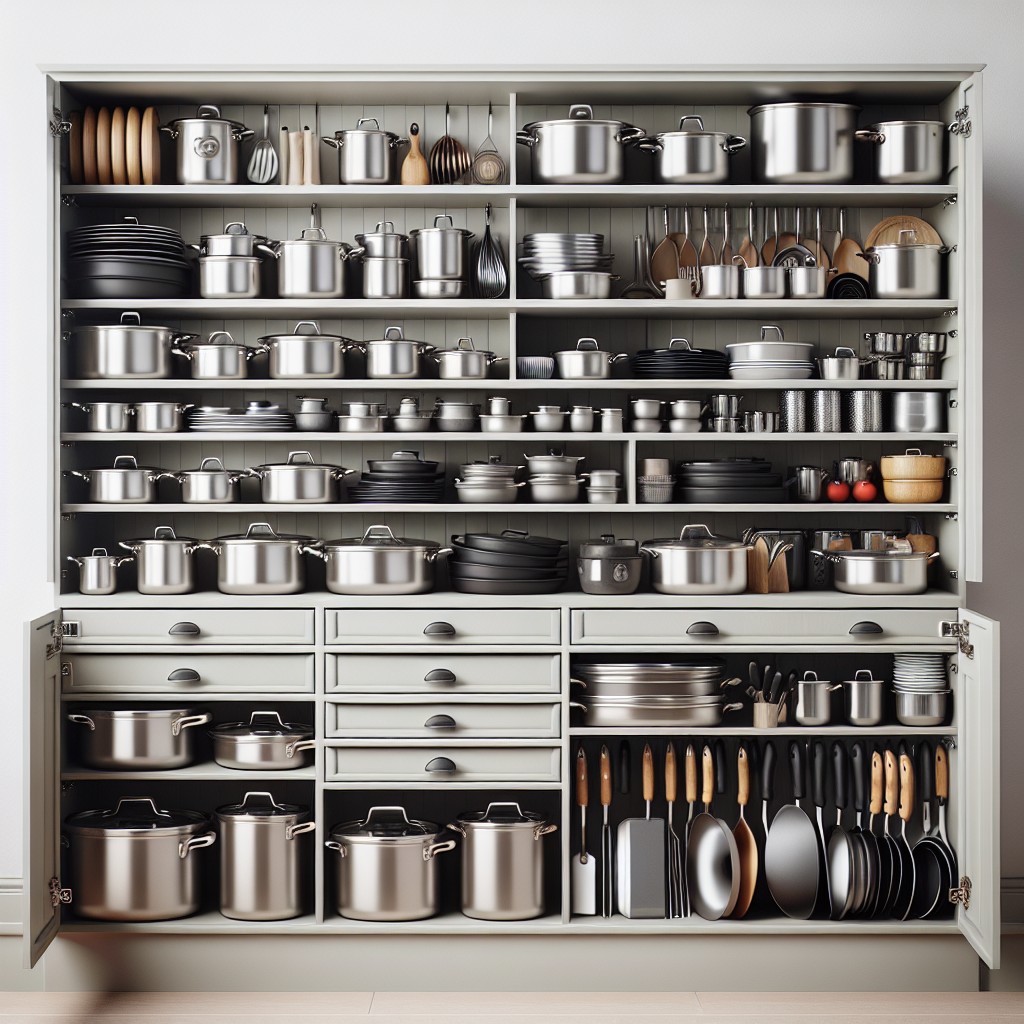
Taking a look at the space beneath the kitchen sink, it’s likely currently underutilized. This often overlooked area can be transformed into a prime storage location for your pots and pans.
First, ensure the area is dry and adequately protected from any plumbing leakage, to avoid damage to your cookware. Now, lay out a sturdy liner or mat to protect both the cabinet floor and your pan bottoms.
Employ pull-out shelving or baskets to improve access and visibility. While these are beneficial for deep sink cabinets, even without these additions, large pots can be stacked directly on the cabinet floor.
Alternatively, consider installing a tension rod across the width of the undersink space. This lets you conveniently hang pots and pans while freeing up substantial room for additional items. This can be especially handy for undermount or farmhouse sinks where there’s more overhead space.
Remember to ensure you create sufficient space to house cleaning supplies or other essentials commonly stored in this location.
With these strategic modifications, the under-the-sink location can serve as a functional, organized space for your pots and pans.
Portable Pot Rack That Fits in a Cabinet
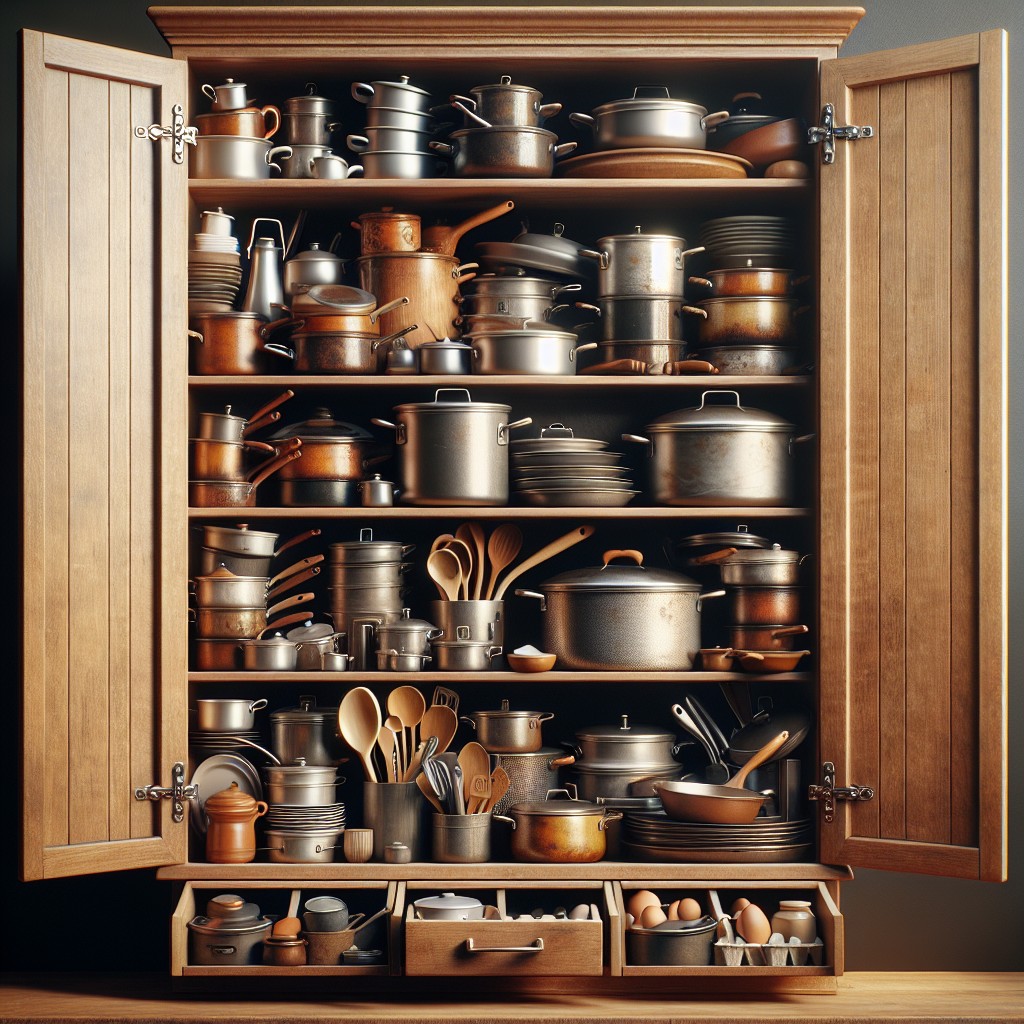
One ingenious solution is a portable rack, perfectly sized to contain an assortment of pots and pans. The benefits are multi-fold. Firstly, it’s simple to install. Just position it into the cupboard and it’s ready for use; no need for tools or complex assembly instructions.
Secondly, it provides an organized space where each pot and pan has its own ‘home’, preventing them from cluttering. It also makes retrieving your cooking equipment a breeze as each item can be easily accessed without having to rummage through a heap of kitchenware.
Thirdly, in scenarios where kitchen layouts are changeable or if you’re moving homes, the portability of the rack comes into play. You can effortlessly remove it from one cabinet and settle it into another.
Considering these points, the portable rack delivers elasticity and practicality while keeping your cabinet tidy. It’s a flexible solution for both temporary and long-term storage needs.
Use an Unused Broom Cupboard for Pan Storage
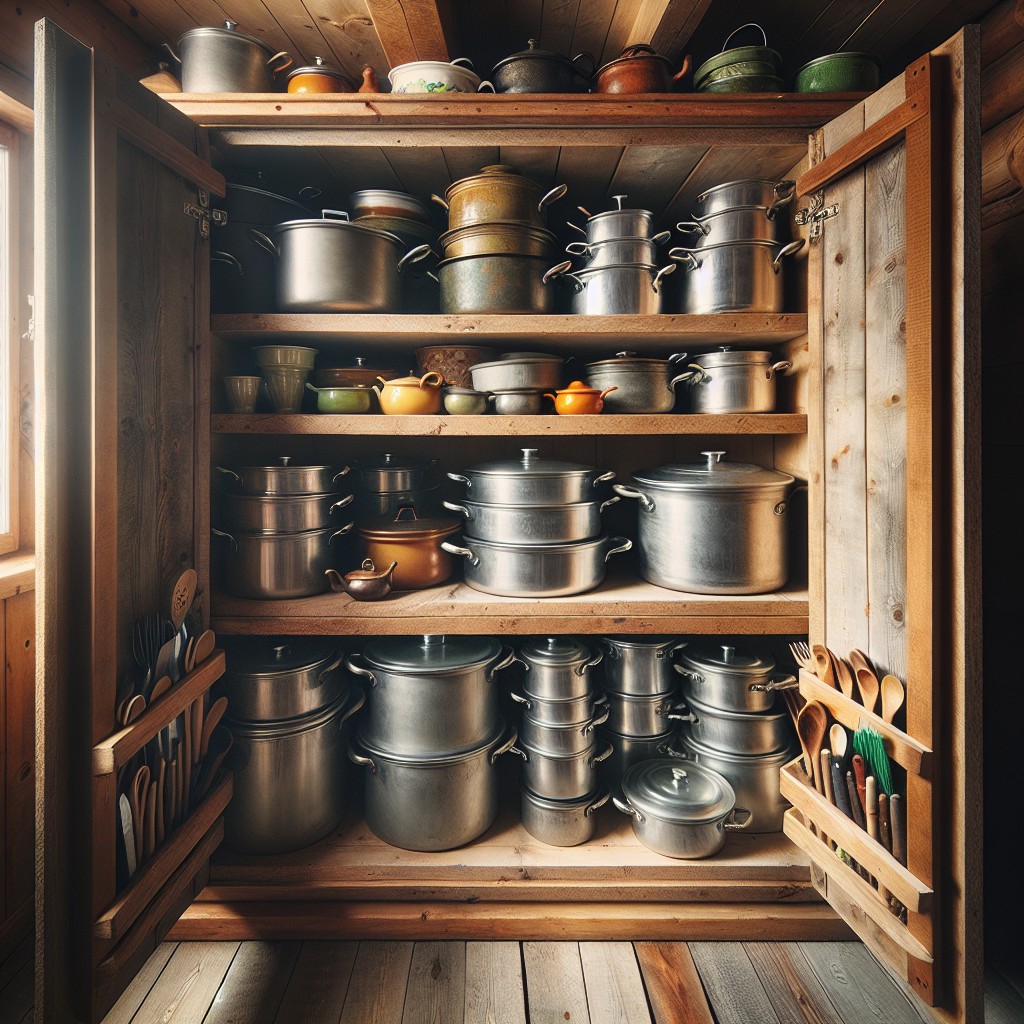
Let’s bring that idle broom cupboard into action. With its tall and narrow structure, it’s capable of tackling your pot-storing needs.
Consider installing wire rack hanging systems, or pegboards on the interior of the door to hold lids and smaller pots.
Multiple layers of adjustable shelving will work wonders for larger pots and stackable pans.
Should you need to store brooms and mops as well, innovative broom holders can be fixed onto the inside door.
Just remember, organization is key here. Keep frequently-used pots within easy reach, while seldom-used items can take the top shelves.
Maximize this space and you’ll wonder how you ever managed without it.
Hooks On the Inside of the Cabinet Doors for Lids
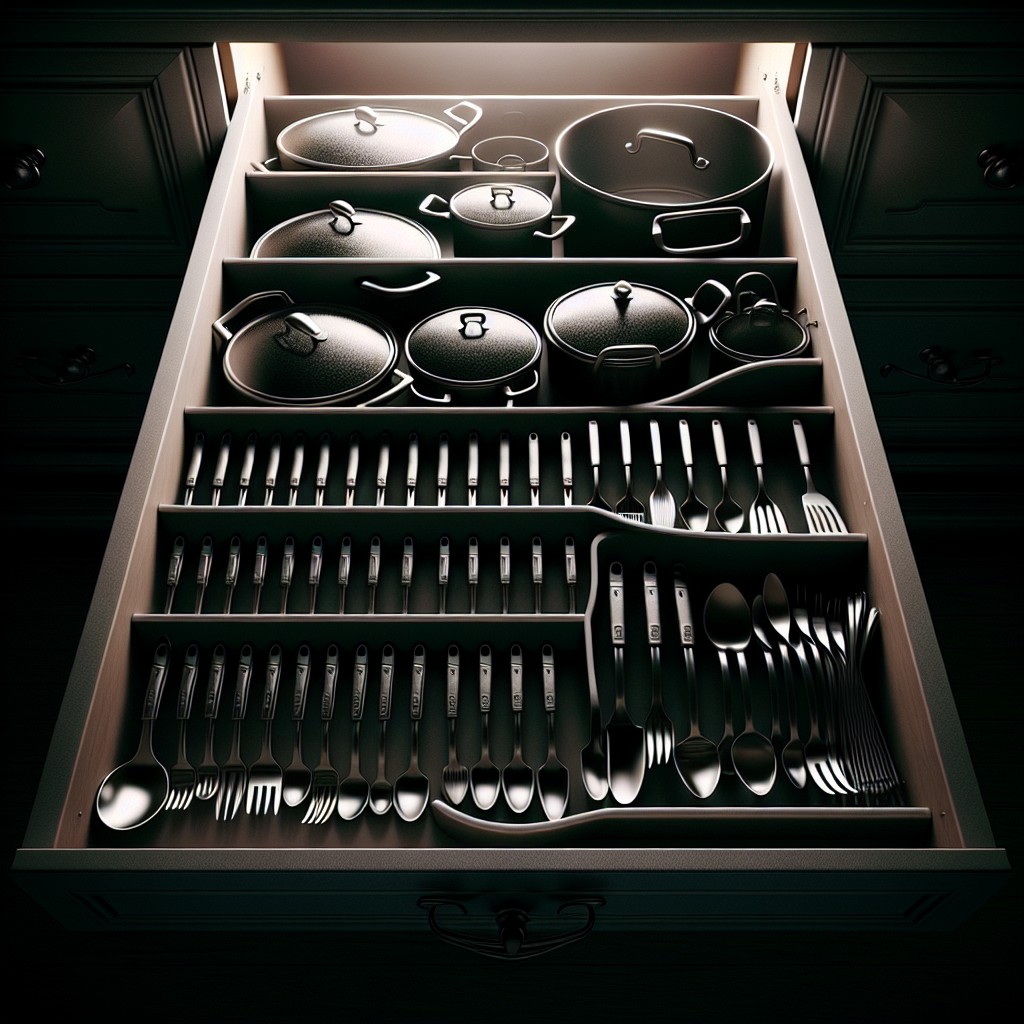
For an efficient use of cabinet space, consider utilizing the bare surface at the back of your doors to store pot lids. This can be achieved by installing some sturdy hooks or a mounted rack.
Here’s how to go about it:
1. Measure the Inside Door: Before you start, ensure to measure the width and length of your cabinet door to ascertain what size of hooks or mounted rack it can accommodate.
2. Choose the Right Hooks or Rack: Choose from adhesive hooks, screw-in hooks, or a specially designed lid rack per your preference and convenience. Ensure they are strong enough to hold the weight of your pot lids.
3. Installation: Adhesive hooks are the easiest to fix. They stick to the door after you peel off the cover at the back. For screw-in hooks or a rack, you need a basic toolkit. Always remember to fix at an accessible height.
4. Arrangement: You can choose to arrange lids according to their sizes for easy access.
Discover a neatly arranged, clutter-free kitchen by taking advantage of the often ignored inner cabinet doors. Happy organizing!
Repurpose a Bookcase Into a Pot Store
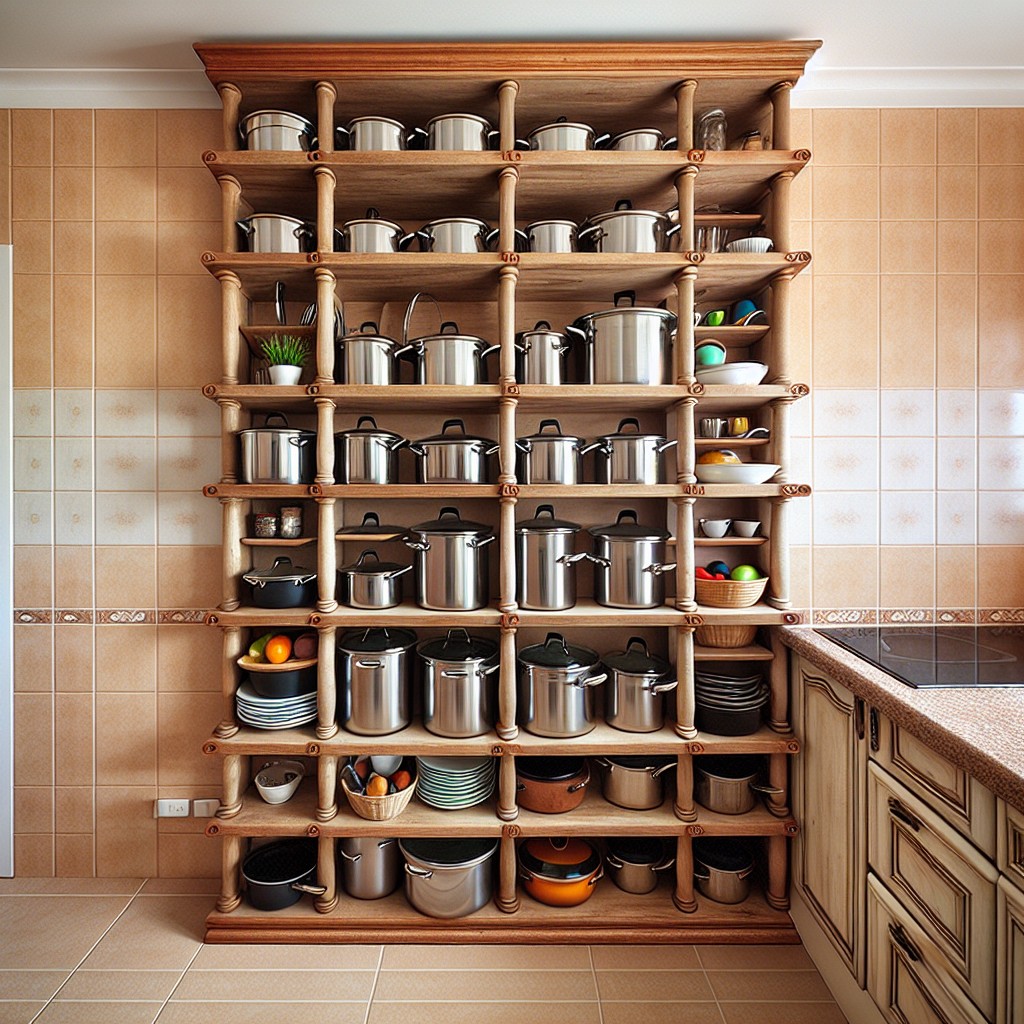
With some creativity, an old bookcase can serve as an unconventional but effective storage solution. Firstly, it’s a great option due to its easily adjustable shelves, that can be tailored to fit pots of varying sizes. To secure larger pots, consider using sturdy bookends or custom dividers. You might need to add some reinforcements for heavier items.
Secondly, openness of the bookcase contributes to easy access and visibility. This means pots won’t be piled on top of one another, which prevents damages like scratches.
Lastly, consider adding a few decorative touches. Add a splash of paint to match your kitchen’s color scheme or use adhesive paper to create a unique backdrop on the inside of the bookcase. Now, you not only have a functional pot store, but also a standalone kitchen feature that catches the eye.
Mount Magnetic Strips Inside Cabinet Doors for Lids
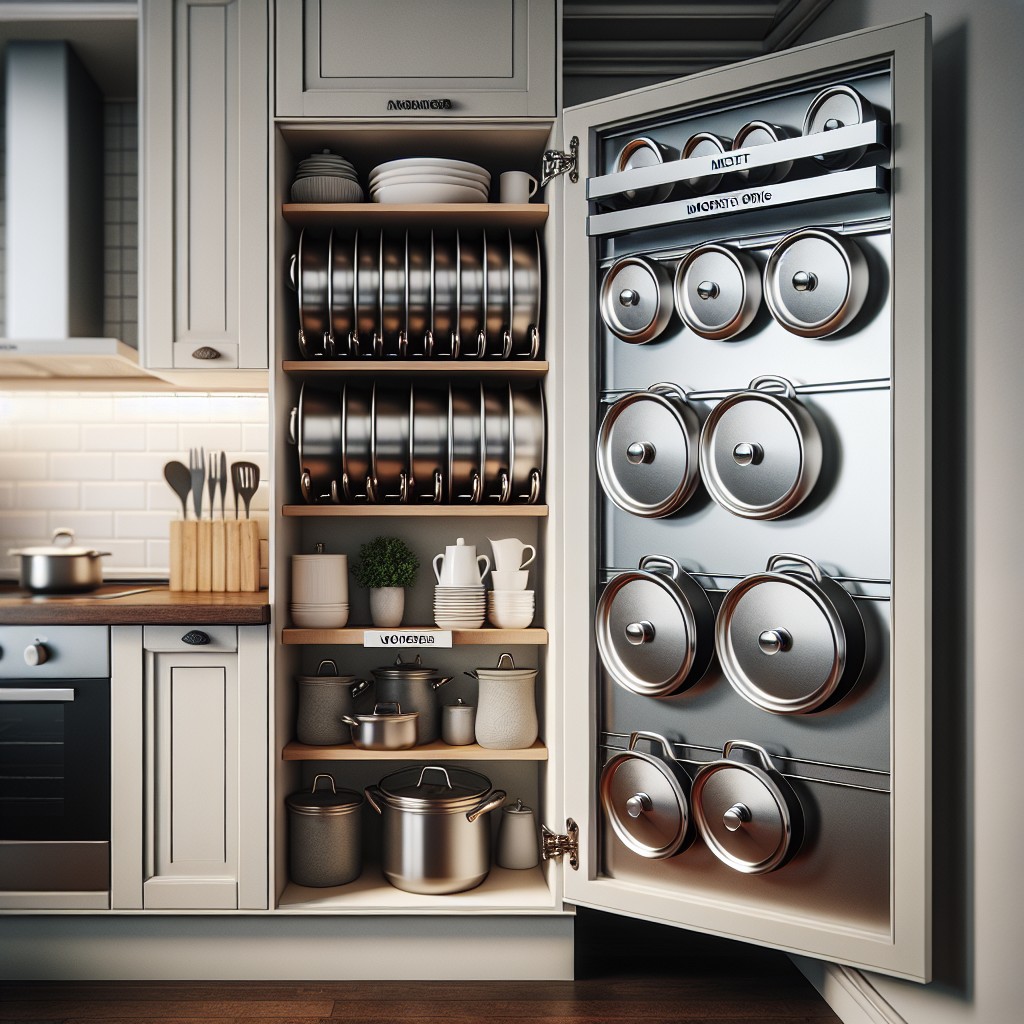
By leveraging the power of magnets, you can create an efficient, accessible lid organization system right inside your cabinet doors. Here’s how:
-Determine the layout: Examine your cabinet doors and plan where to place the strips. It’s best to avoid areas where hinges or shelves might interfere when the door closes.
-Choose your magnetic strips: Opt for heavy-duty magnet strips that can safely hold the weight of your lids.
-Attach the strips: Follow manufacturer instructions to secure your strips. Some can be simply affixed using adhesive backing, while others may require screws.
-Test before use: Before hanging all your lids, hang one first to make sure it holds securely.
By implementing this simple trick, misplaced lids will be a thing of the past and you’ll have your pot drawer cabinet even more organized.
DIY Cabinet Pot Rack With a Curtain Rod
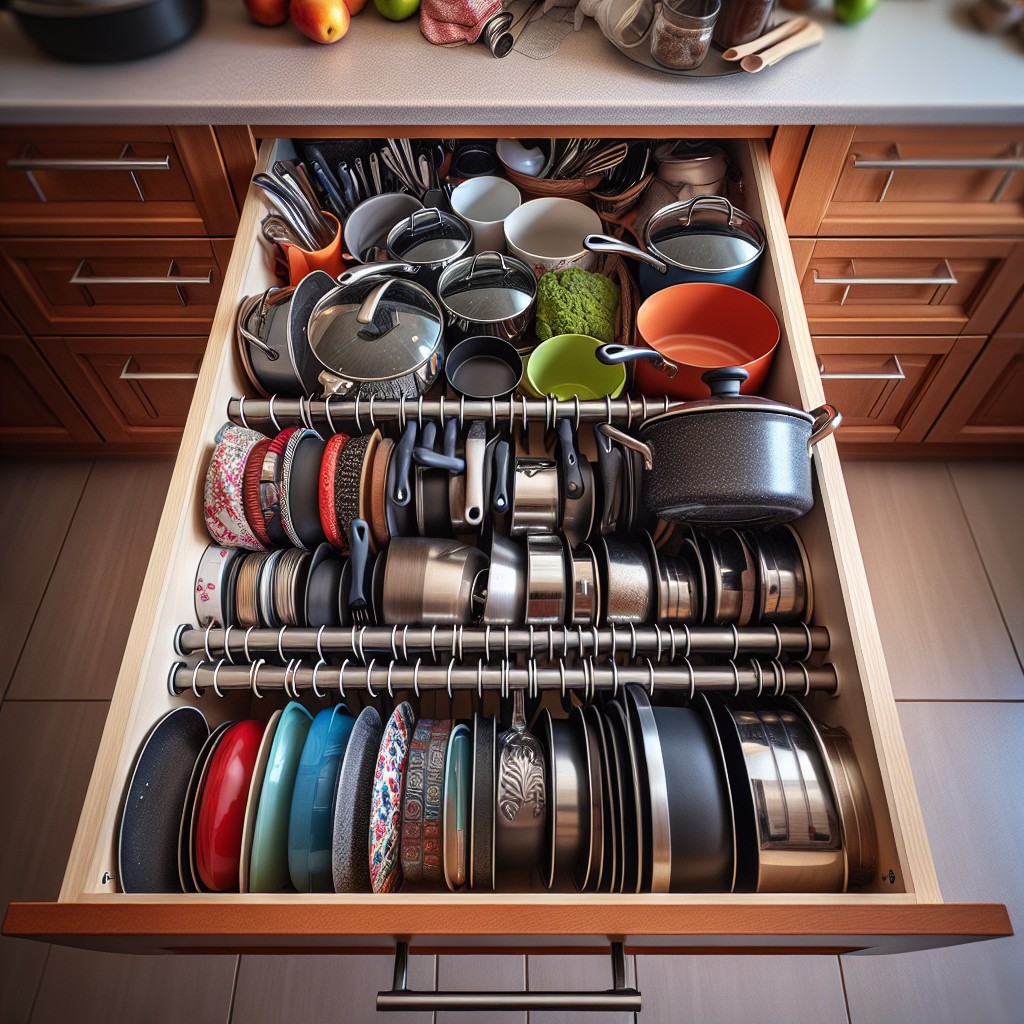
Starting with an old or thrifted curtain rod can set the tone for this venture. Pick one that fits your cabinet’s inside dimensions. A small bit of elbow grease goes a long way in prepping the rod with an attractive layer of paint or polish.
This setup works best for those lightweight pots and lids, along with utensils if needed. The installation itself requires just a few small bracing fixtures, often provided with the rod, attached to the cabinet’s inner sides. Screw these at the preferred height and pop the rod into place.
Spacing becomes a game-changer. Make sure you lace your pots, lids, or utensils with an interval good enough for comfortable retrieval. Utilizing ‘S’ hooks aligned sideways on the rod opens up a world of possibilities, not just for pots but a variety of kitchen tools.
Get creative with the rod’s color and design, and you have a pragmatic accessory that doubles as an interior feature. Remember, always support substantial weight at either end to prevent sag, especially for wider cabinets. Happy DIY-ing!
Multi-tiered Pots and Pans Carousel
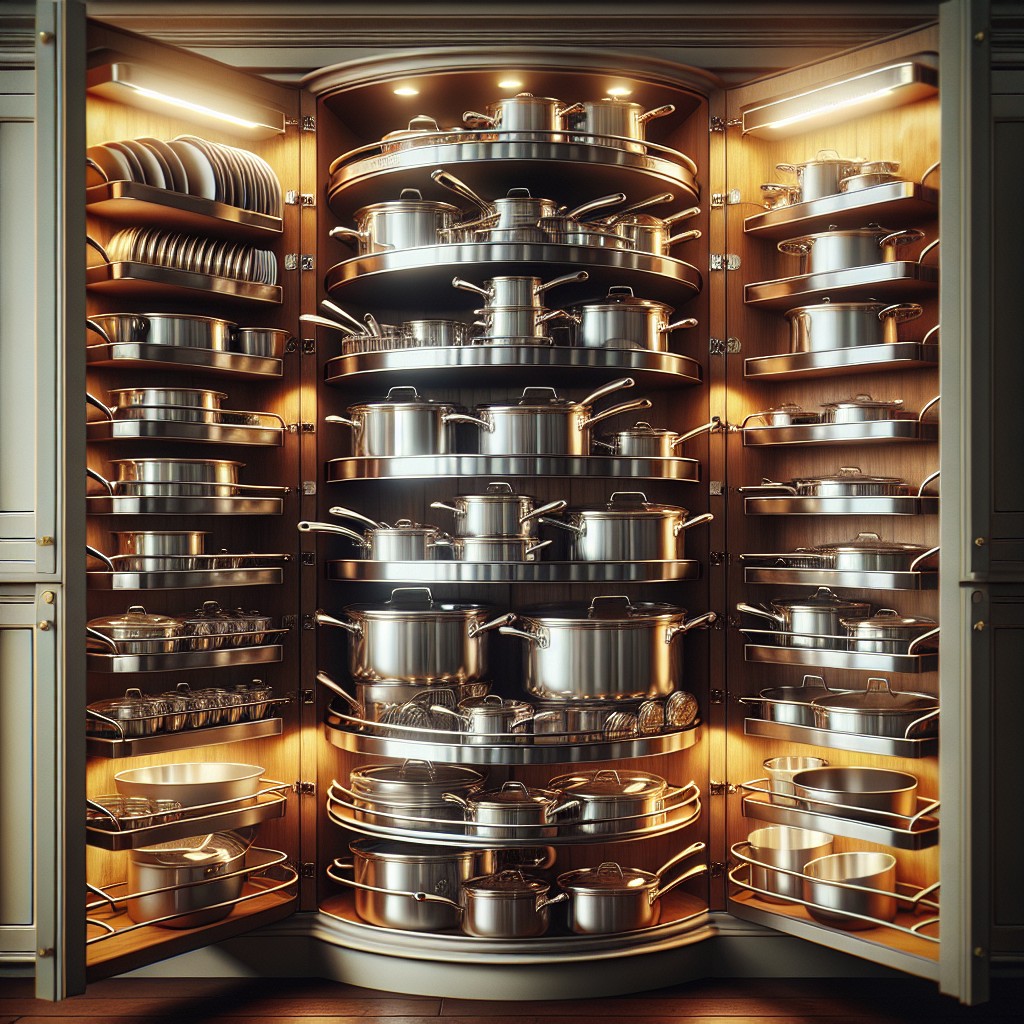
Optimizing cabinet space is key in any kitchen, and the multi-tiered carousel does just that. It’s an excellent strategy for smaller environments, where space is a luxury. This clever tool spins 360 degrees, allowing easy access to all stowed items.
Best of all, pots, pans, and lids of varying sizes can nestle neatly together using this method – it’s visually pleasing and highly functional. Plus, with all items visible at first glance, you avoid aimless rummaging.
Metal or plastic models are available, with installation often being a simple DIY project. Just ensure the weight bearing capacity is sufficient for your cookware. Always measure the space before buying to guarantee a perfect fit.
Hidden Drawers Within the Kitchen Island
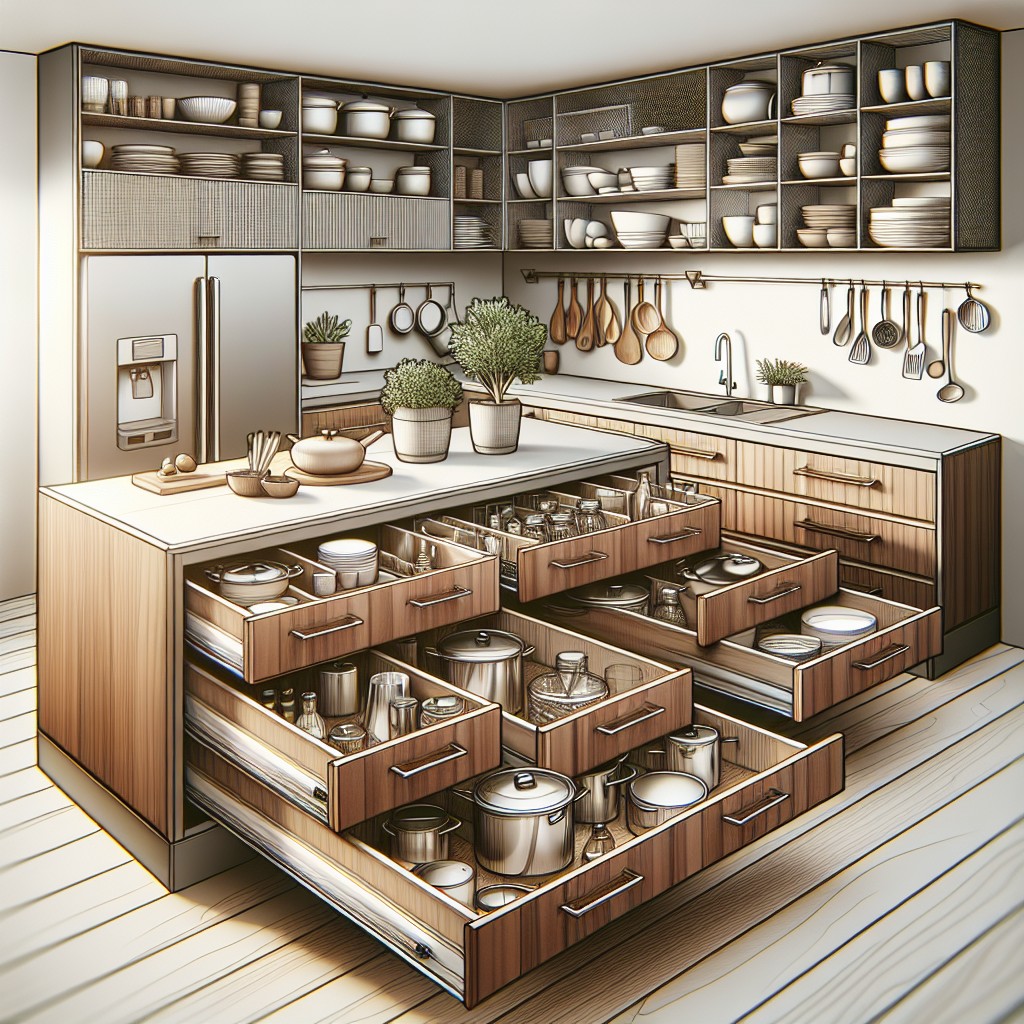
Taking advantage of the kitchen island space with hidden drawers can be quite efficient. It allows easy access while keeping your pots and pans out of sight when not in use.
Optimal design can include large, deep drawers that feature sturdy dividers, ensuring your cookware isn’t damaged when stored and remains organized for easy access. This method promotes easy workability, as your essential tools are conveniently located near the cooking area.
A tip to consider – opt for soft-close mechanisms for a luxurious feel and to prolong the life of the drawer. Another consideration: non-slip drawer liners will keep pans from sliding around and causing damage.
Remember, each kitchen’s configuration and users’ needs are unique, so customize drawer sizes and styles accordingly.
Convert a Closet to a Pot and Pan Cabinet

Begin by emptying the entire closet, removing any shelving or rod attachments that may interfere with the new layout. The conversion’s first step involves adding robust, adjustable shelving to accommodate the variety of pot and pan sizes.
Consider installing pull-out drawers or wire baskets on lower levels for easy access to heavy items. Additionally, using door-hanging racks can provide extra space for lid storage, maximizing the closet’s utility. Don’t forget the need for proper ventilation, particularly if the closet is nearby cooking and baking areas.
Touch-ups such as lining the shelves with non-slip liner and labeling each shelf or drawer by pot type will give your new storage spot a well-organized, professional appearance. This small transformation will immensely ease your cooking routine and make your kitchen seem more spacious and clutter-free.
‘Staircase’ Storage Drawers for Pots and Pans
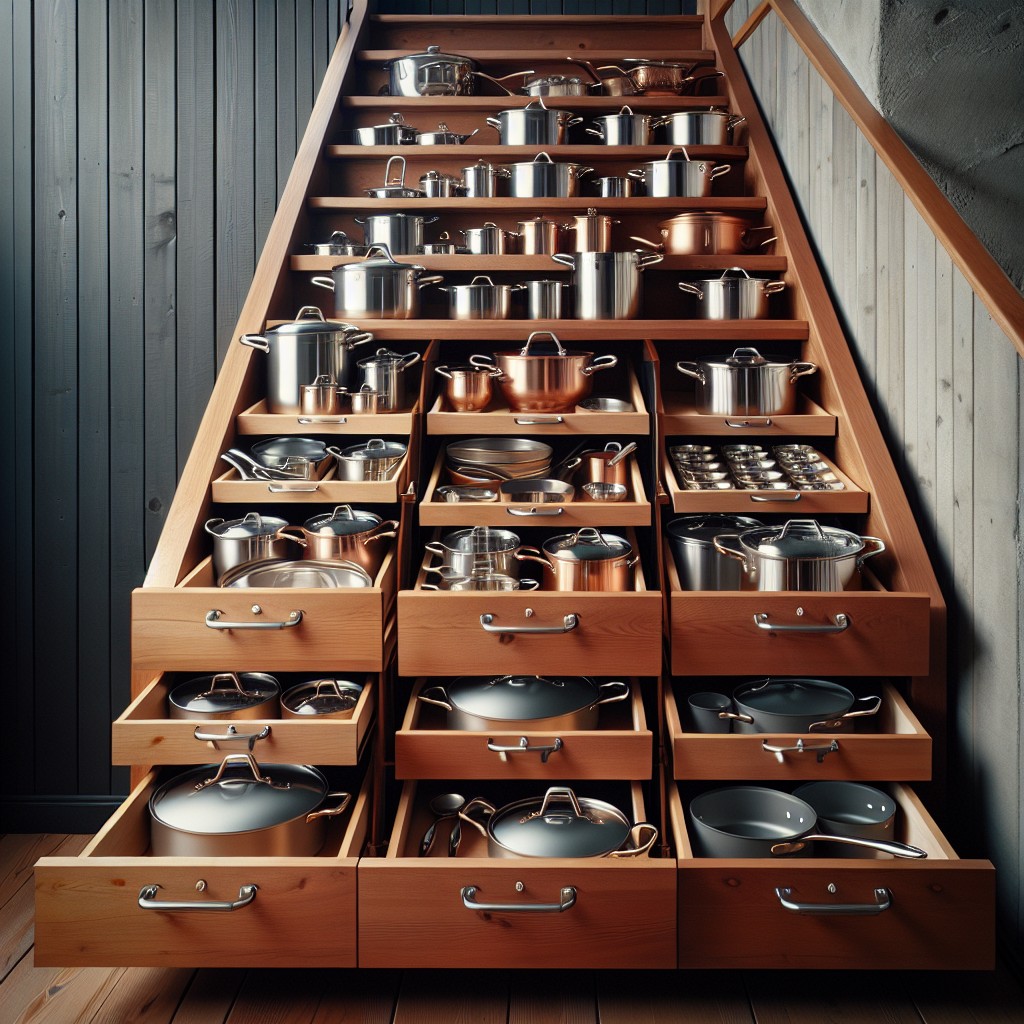
‘Staircase’ storage drawers offer an ingenious solution to the typical chaos of a cluttered kitchen. Implementing this design gives you a clear view and direct access to pots and pans, making cooking a more enjoyable and efficient experience.
Here are the crux points of this functional and aesthetic feature.
1. Easy Identification:

With staircase drawers, you don’t have to rummage around for your desired pot or pan. Each item is clearly visible, much like a display case.
2. Space Management:

Each stair-like section optimally uses vertical storage space to hold a pot or a pan, vastly improving cabinet organization.
3. Versatility:

This design can be built into existing cabinets or integrated into new designs, making it suitable for all kitchen sizes and layouts.
4. Enhanced Durability:

Designing the drawers with sturdy materials like thick plywood or metal can support heavy cookware, extending the life of your cabinets.
5. Customizability:
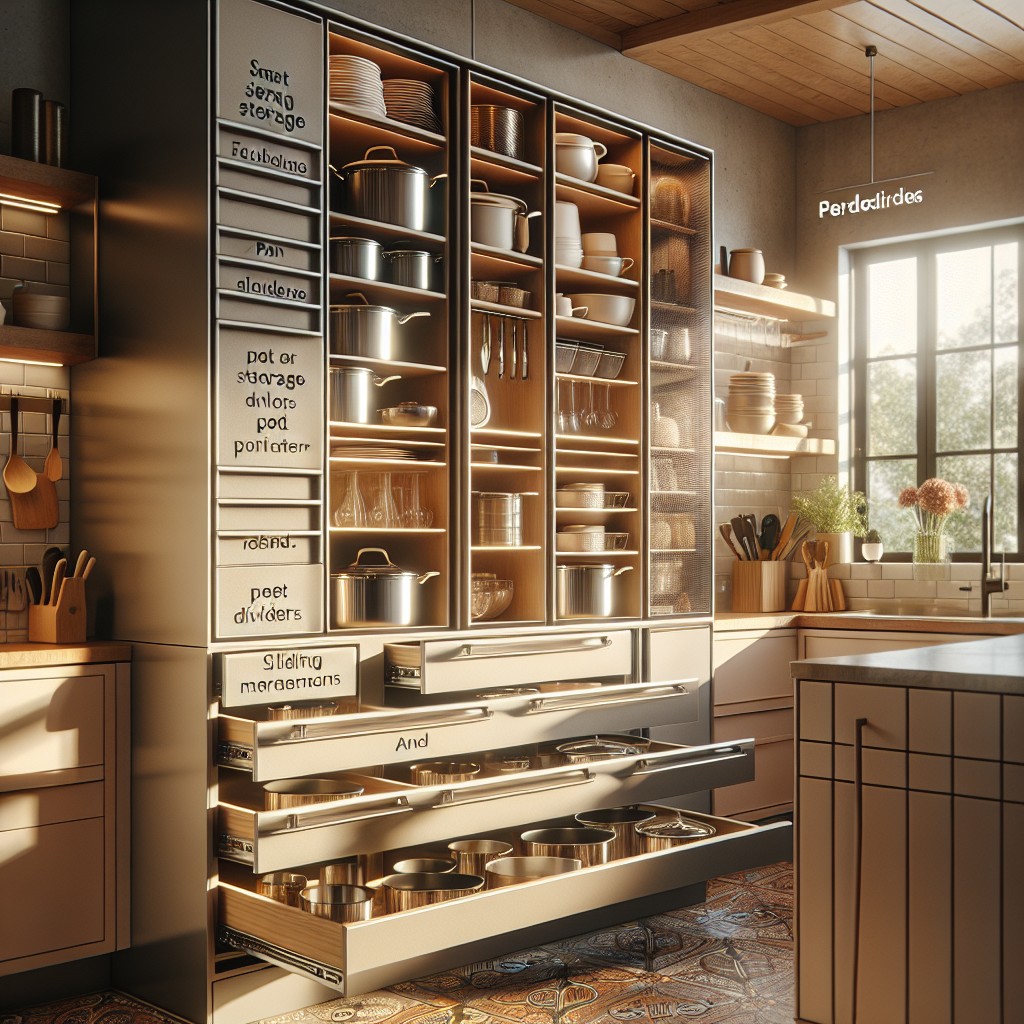
Opt for drawers with adjustable dividers to accommodate different sizes and shapes of cookware for a truly tailored kitchen storage solution.
Corner Cabinet Lazy Susan for Pot Storage

A Lazy Susan is a practical, space-saving solution designed for easy access and optimal use of cabinetry corners. Equipped with a rotating mechanism that allows you to effortlessly spin it around, it renders every item within reach.
Spacious layout: It offers enough room to store even your bulky pots and larger pans.
Easy access: No need to stretch or squat to retrieve your cookware. Just rotate the shelves to bring items to the front.
Organized storage: With its tiered structure, you can easily segregate pots, pans, and lids, keeping your items orderly.
Easy to clean: A simple wipe down is often enough to keep the shelves spotless.
So make the most of your cabinet corners with the installation of a Lazy Susan, turning awkward space into a functional storage hub for your pots.
Tilt-out Storage Under the Sink for Pots
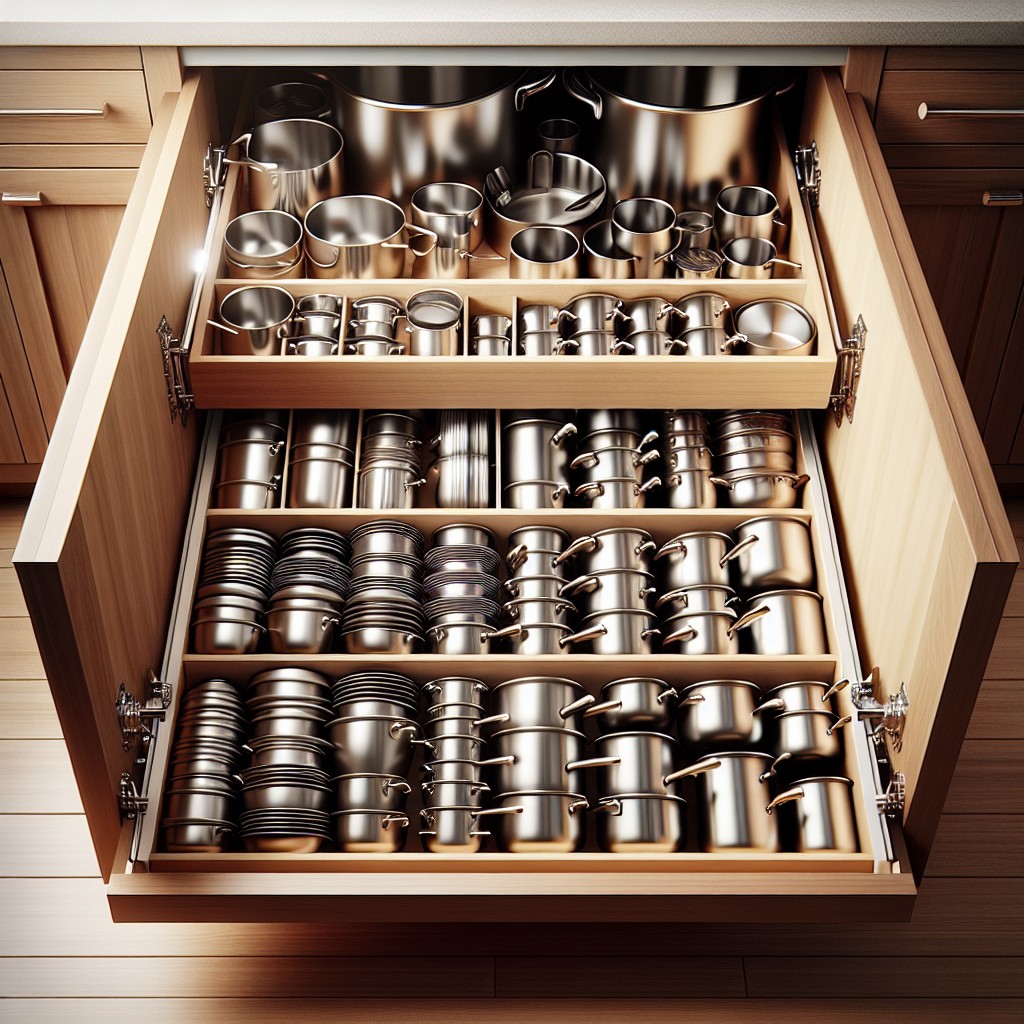
Maximising your kitchen space demands ingenuity. One notion to consider is making use of the under the sink area, specifically through the use of tilt-out storage. This type of storage has the unique advantage of providing easy access to your pots while making the most of usually unutilized space.
To effectively implement this concept, consider these key points:
- Measure the Available Space: Height, depth, and width are essential components for the optimal utilization of space.
- Choose a Durable Tray: Since this location can become damp, resilience to humidity is essential.
- Proper Installation: Ensure the tilt-out tray operates smoothly and securely. Depending on weight requirements, you might need to install extra supports.
- Optimal Arrangement: Arrange pots in a way that takes advantage of the unique space, with frequently used items up front for easy access.
By taking these factors into account, you can make a seemingly small or cluttered area into a functional and effective storage space for your pots.
Recessed Cabinetry for Large Pot Storage
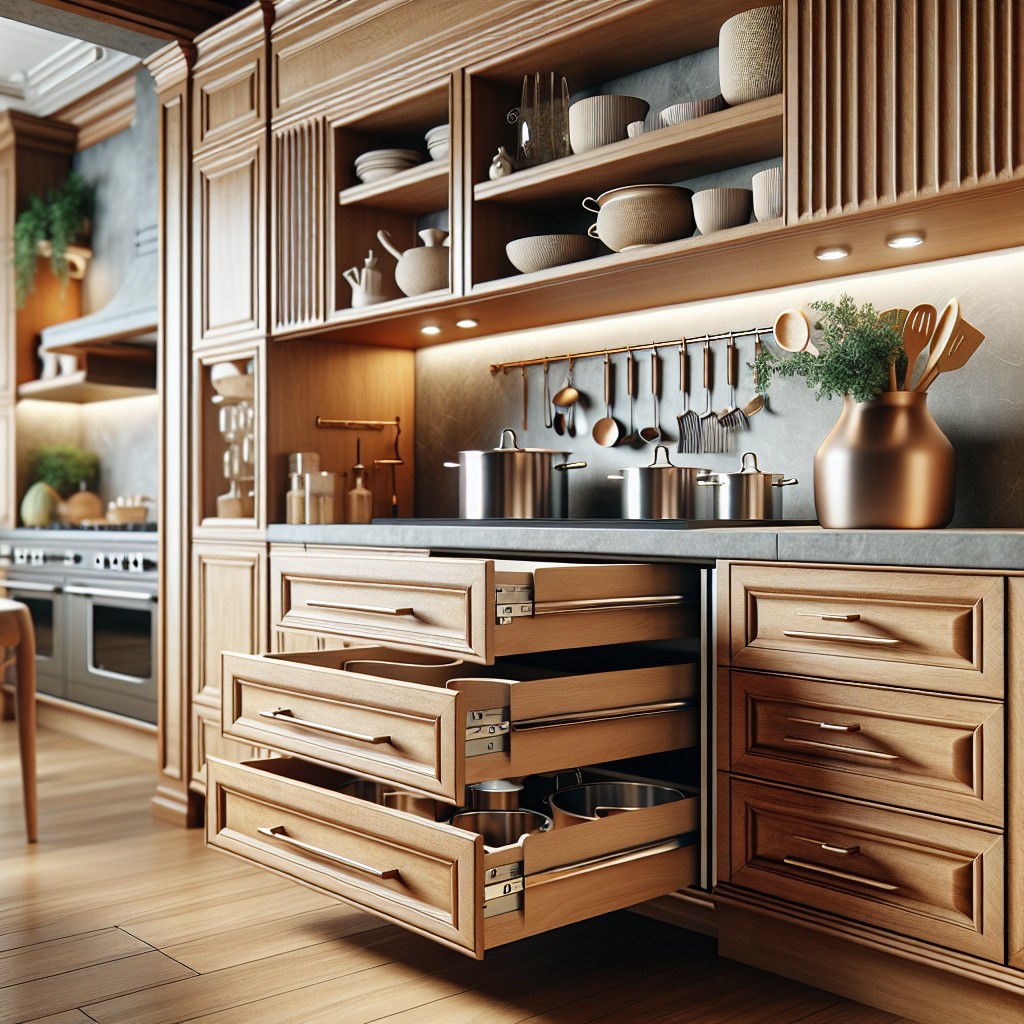
For those large pots that are tricky to store, recessed cabinetry is a fantastic solution. This design approach utilizes the typically unused space within the depth of your kitchen walls. It’s about carving out a specific, designated area to fit these large pieces of cookware.
To start, enlist a professional to ensure your wall can handle such alterations, considering essential wiring and plumbing. Then, think about positioning. You may want to place your recessed cabinets close to the stove for easy access. Remember to fix in shelving at varying heights to accommodate a range of pot sizes.
In terms of design, match the cabinet front with your existing cabinets for a seamless blend with your kitchen’s aesthetic. Or, opt for glass doors to boast your pot collection. Recessed cabinetry not only offers ample storage but also maintains a clean, streamlined look in your kitchen area.
Sliding Door Pot and Pan Cabinets
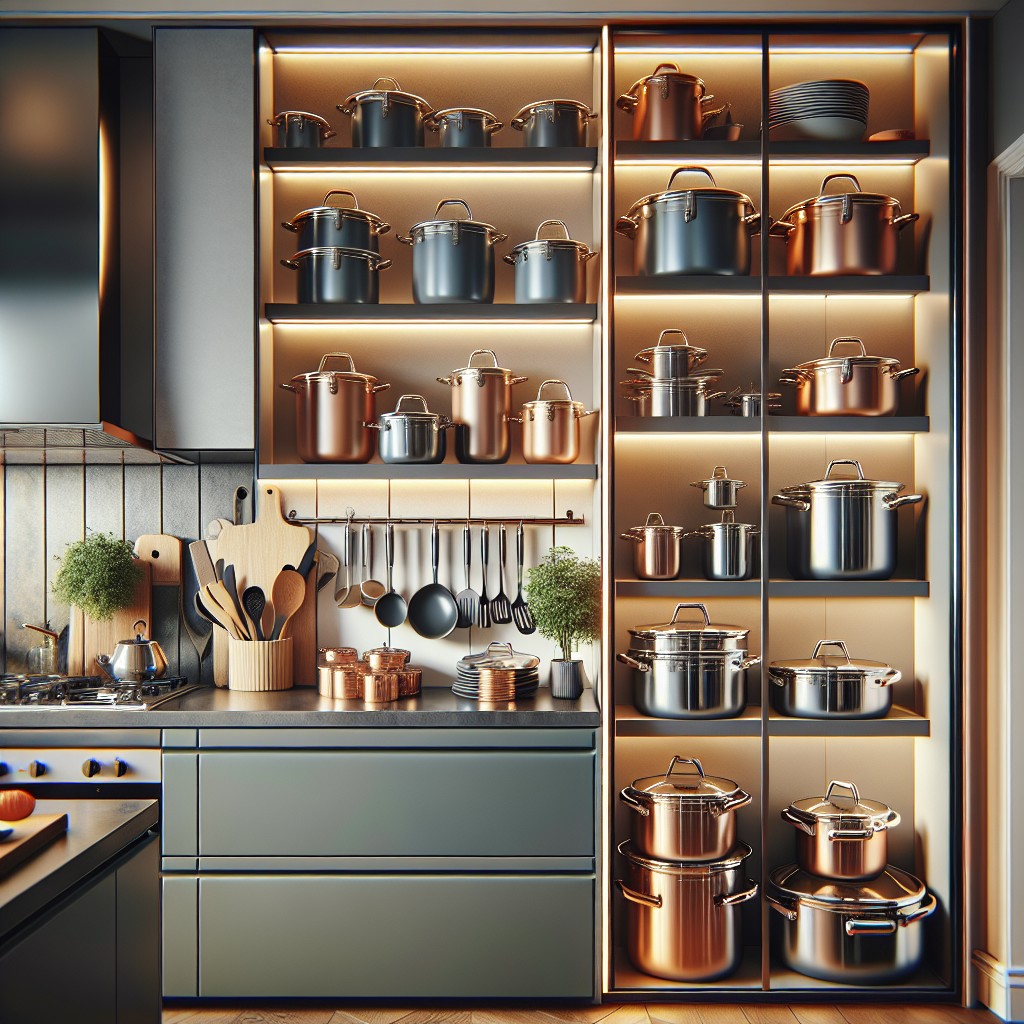
Sliding door cabinets offer an appealing solution for optimizing kitchen space and maintaining an organized and efficient cooking zone. As they slide, rather than swing open, you save precious space, allowing for a less cluttered kitchen.
To best use these cabinets, try dedicating upper compartments specifically to frying pans and saucepans, with those often used at eye level. Ensure the weight is evenly distributed and heavier items are closer to the edges to prevent door derailment.
For the lower compartments, nested pots work beautifully. Pairing each pot with its corresponding lid directly beside it also increases efficiency.
Remember – coordinating materials and colors of your pots will enhance the aesthetics of a glass-fronted sliding cabinet. Consider this if you’re looking to leave visitors impressed with your trendy kitchen!
Cabinet Pot Rack With Hooks and a Shelf
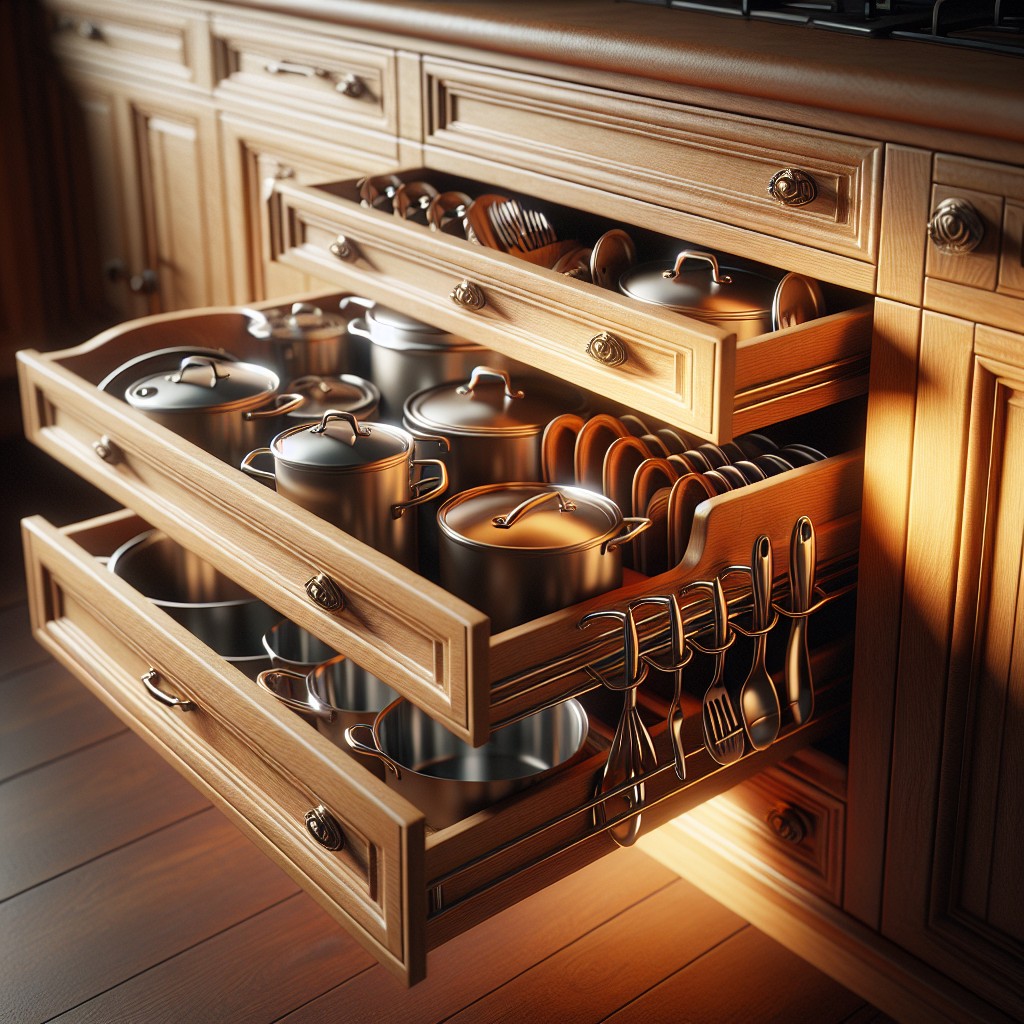
First off, measure the inside dimension of the cabinet to ensure a snug fit for the rack and shelf. Secure the pot rack firmly against the cabinet ceiling, always ensure the hooks face downwards.
Make it even more functional by attaching a shelf above the pot rack – great for storing pot lids or small kitchen appliances.
Remember, the stronger the material, the more weight the rack can hold. Iron or stainless steel are well-reputed for their strength, while wood brings a touch of warmth and rusticity.
When arranging your pots, consider frequency of use – most used at the front, less used at the back.
Pots and Pans Rack Inside a Pantry
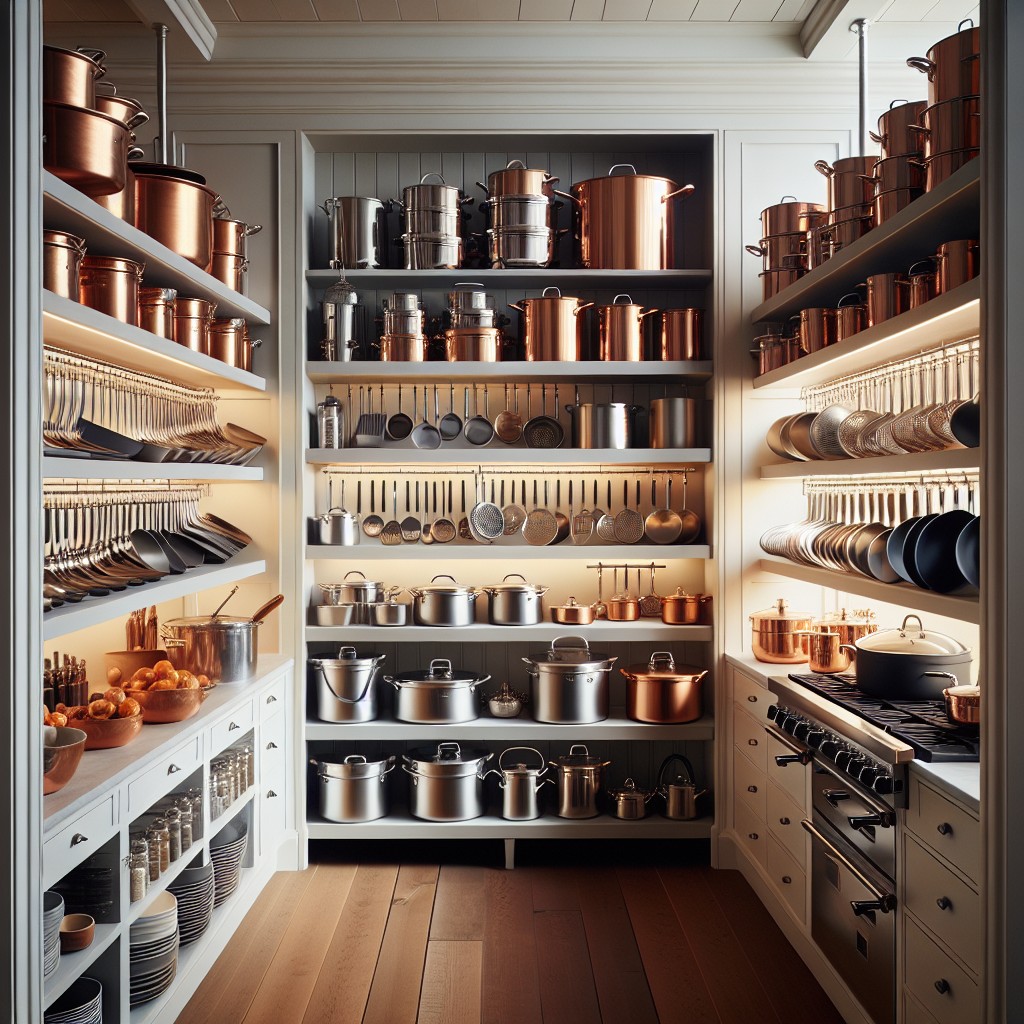
Utilizing the space in your pantry can be an efficient way to organize your pots and pans neatly. A rack specially designed for this purpose can be both functional and aesthetic.
1. Rack Type: Choose a rack that suits your needs. Consider a freestanding or wall-mounted option. Freestanding racks can be moved around while wall-mounted ones save space.
2. Proper Spacing: Ensure there’s enough distance between each pot and pan. This prevents cluttering and makes it easy to retrieve what you need.
3. Heavy at Bottom: Place heavier pots at the bottom of the rack. This ensures stability and reduces risk of accidents.
4. Include Lids: Some racks come with special compartments for lids. If yours doesn’t, you can invest in secondary storage like hooks or magnetic strips.
5. Accessibility: Keep the rack near your cooking area for easy access. Avoid corners or inaccessible spaces that may cause inconvenience.
By taking these key factors into account, you can make the most of your pantry space and keep your pots and pans in perfect order with a rack.
Behind-the-door Cabinet Organizer for Pots and Pans
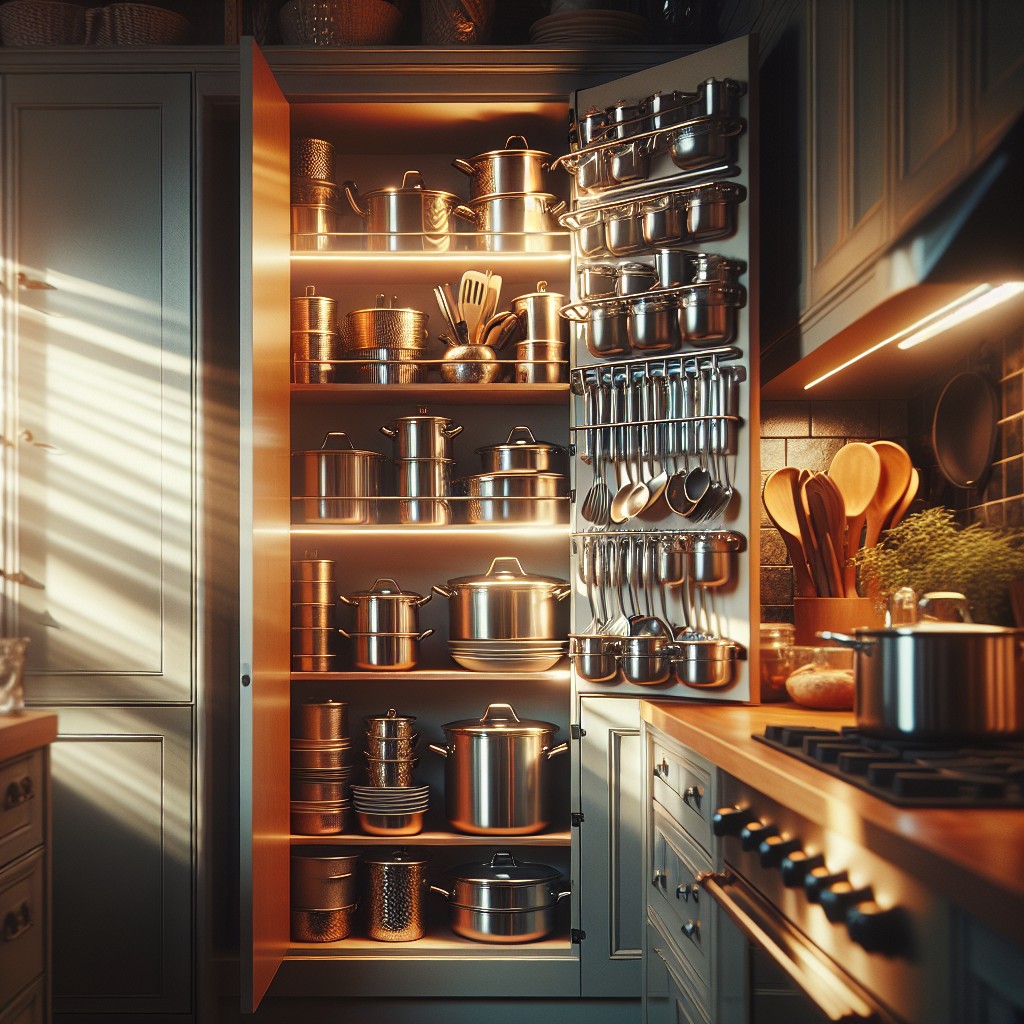
Maximizing your cabinet doors as storage holds tremendous potential. This space-optimizing, out-of-sight solution is excellent for stashing lids or smaller pots.
There are various organizers on the market designed explicitly for cabinet doors. Typically easy to install, they offer scalable solutions depending on the size of your door and the items you intend to store.
Another positive note is that they eliminate the noise that can come from a cluttered cabinet—no more clanging pots every time you need to grab a saucepan!
Venturing into DIY territory, hooks, bars, or even magnetic strips could work wonders. The key is to measure your door and the items you plan to store astutely. Ensuring you do not inhibit the door’s closure is crucial.
Ideas Elsewhere
- https://www.cliqstudios.com/blog/top-5-recommended-kitchen-cabinets-for-organizing-pots-and-pans/
- https://www.homesandgardens.com/kitchens/organizing-pots-and-pans
- https://www.theorganizedmama.com/organize-pots-pans/
- https://www.bhg.com/kitchen/storage/organization/genius-storage-solutions-for-pots-and-pans-281474979471876/
- https://www.thespruce.com/how-to-organize-pots-and-pans-6361713
- https://www.bhg.com/kitchen/storage/organization/pullout-kitchen-storage-ideas/
